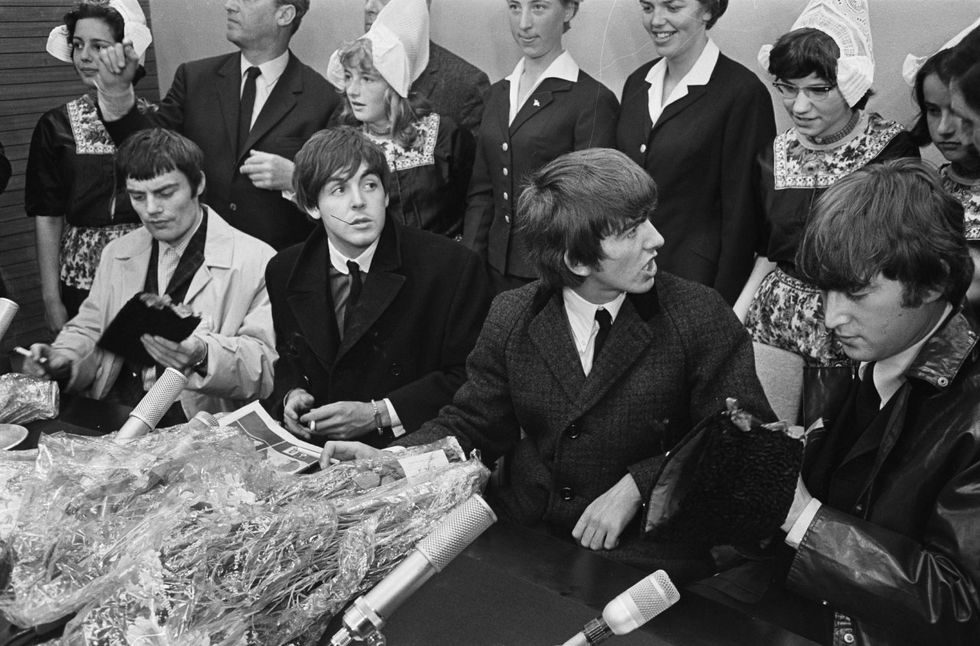Many people have claimed that genetically modified foods are dangerous and should not be sold or should at least be labeled in grocery stores so that people can choose whether or not to purchase them. Sometimes this argument is based on reasonable skepticism, for example, if a person believes that genetically modifying food is a radical new practice that has yet to be tested or if he or she has heard the rumor that scientific studies have found GMOs to have harmful health effects. Other times, such claims are based on the completely ridiculous fear of things that are "unnatural" rather than "organic," which is a logical fallacy and displays a disappointing display of willful ignorance. In either case, though, the concerns are misplaced.
First of all, we should clarify what is meant by a "genetically modified organism." The term "genetically modified" is ominous in and of itself and evokes frightening imagery of scientists going "too far" by tinkering with the basic properties of life. However, all that it refers to is a living thing that has been selectively bred. That's it. If you own a dog, you own a GMO. If you own a cat, you own a GMO. Farmers have been genetically modifying their crops to produce the healthiest and most plentiful crops for thousands of years. If not for this process of selective breeding, your food would look something like the image below, as explained by Business Insider.
The only difference between previous genetic modification and modern genetic modification is that, using modern technology, we can now selectively breed crops with more efficiency. We're just doing what we have always been doing, except better. Take the "Innate" potato as an example, which has bypassed many of the problems that we have had with traditional potato breeding:
"It's very difficult, using traditional breeding, to make gradual improvements in an established potato variety. Mating it with another variety produces tremendously varied offspring, the vast majority of them inferior to the variety that you were hoping to improve. It's like trying to improve a really good poker hand by reshuffling the whole deck of cards and dealing again...The Simplot Co. chose the word 'innate' because the new genes it inserted are actually modified versions of some genes that exist naturally in potatoes; they are innate to this species. But the inserted genes have a curious effect: They shut down a few of the potato's original, natural genes. Scientists call it gene silencing...[After going through bruise tests, the] traditional russet Burbank potatoes are starting to show some evidence of bruising...We see few bruises, by contrast, on the Innate russet Burbank potatoes. [And] here's another difference that we cannot see. If we fry these potatoes, the Innate russet Burbanks will have less than half as much of a worrisome chemical called acrylamide." In this way as well as others, we can use modern genetic technology to improve our food more efficiently.
That, however, was only one example of a GM food product that became safer through the process of genetic modification. And what if it has some new hidden safety hazard that has yet to be discovered due to the lack of scientific research? While understandable, that concern is completely invalid.
Some people believe that there has been very little research on the health risks posed by GMOs and/or that the existing research has yielded conflicting results. Frankly, they are wrong. Here is one example, or rather almost two thousand: "[i]n response to what they believed was an information gap, a team of Italian scientists summarized 1783 studies about the safety and environmental impacts of GMO foods—a staggering number." The researchers couldn’t find a single credible example demonstrating that GM foods pose any harm to humans or animals. “The scientific research conducted so far has not detected any significant hazards directly connected with the use of genetically engineered crops,” the scientists concluded." These studies are all catalogued and stored in the Genetic Engineering Risk Atlas (GENERA) databank, which contains over 650 GMO studies in addition to the 1783 reviewed by the Italian research team.
If those studies are not convincing enough, for whatever reason, consider the largest and most comprehensive study of GMO food in history, conducted by Alison Van Eenennaam and Amy E. Young at the University of California-Davis Department of Animal Science. They "reviewed 29 years of livestock productivity and health data from both before and after the introduction of genetically engineered animal feed...The field data represented more than 100 billion animals covering a period before 1996 when animal feed was 100% non-GMO, and after its introduction when it jumped to 90% and more. The documentation included the records of animals examined pre and post mortem, as ill cattle cannot be approved for meat. What did they find? That GM feed is safe and nutritionally equivalent to non-GMO feed. There was no indication of any unusual trends in the health of animals since 1996 when GMO crops were first harvested. Considering the size of the dataset, it can reasonably be said that the debate over the impact of GE feed on animal health is closed: there is zero extraordinary impact."
Among the thousands of studies demonstrating that GMOs are not a health concern, though, are a few studies that suggest the reverse. Most if not all of them are invalidated by their shabby methodology. For instance, one study that is cited fairly often by anti-GMO alarmists attempted to link GM corn to the development of tumors and other deadly ailments in rats. It was published in 2012 in Food and Chemical Toxicology, which then retracted the study because "scientists and regulatory agencies concluded that the conclusions of the paper to be invalid on the basis of the experimental design; each arm in the study had too few rats to obtain useful data in a lifetime study of Sprague-Dawley rats, which get cancer at a high rate over their lifetime." The author of the study, Gilles-Éric Séralini, had refused to withdraw it and decided to republish it in a different journal (Environmental Sciences Europe) without any further review.
For all of these reasons and more, the American Association for Advancement of Science , which is a non-profit organization and the world’s largest multidisciplinary scientific professional society, firmly supports the genetic modification of organisms, and opposes the labeling of GMOs in grocery stores. A statement by the AAAS Board of Directors declared that "Foods containing ingredients from genetically modified (GM) crops pose no greater risk than the same foods made from crops modified by conventional plant breeding techniques...[and] legally mandating labels on GM foods could therefore 'mislead and falsely alarm consumers'...Several current efforts to require labeling of GM foods are not being driven by any credible scientific evidence that these foods are dangerous...Rather, GM labeling initiatives are being advanced by 'the persistent perception that such foods are somehow "unnatural,"' as well as efforts to gain competitive advantages within the marketplace, and the false belief that GM crops are untested. In the United States, in fact, each new GM crop must be subjected to rigorous analysis and testing in order to receive regulatory approval...It must be shown to be the same as the parent crop from which it was derived and if a new protein trait has been added, the protein must be shown to be neither toxic nor allergenic. As a result and contrary to popular misconceptions...GM crops are the most extensively tested crops ever [emphasis added].”
The AAAS is not alone is its position. As they pointed out in the above statement, "the World Health Organization, the American Medical Association, the U.S. National Academy of Sciences, the British Royal Society, and every other respected organization that has examined the evidence has come to the same conclusion: consuming foods containing ingredients derived from GM crops is no riskier than consuming the same foods containing ingredients from crop plants modified by conventional plant improvement techniques.” It also ought to be mentioned that there is a 51 percentage point gap between the opinions of AAAS scientists and the U.S. public on the issue of GMOs - 37% of U.S. adults and 88% of AAAS scientists think that GMOs are safe to consume.
So if you are worried about the health problems posed by GMOs, don't be. A monumental amount of scientific evidence has shown that they are perfectly harmless.






 Going to the cinema alone is good for your mental health, says science
Going to the cinema alone is good for your mental health, says science












 women in street dancing
Photo by
women in street dancing
Photo by  man and woman standing in front of louver door
Photo by
man and woman standing in front of louver door
Photo by  man in black t-shirt holding coca cola bottle
Photo by
man in black t-shirt holding coca cola bottle
Photo by  red and white coca cola signage
Photo by
red and white coca cola signage
Photo by  man holding luggage photo
Photo by
man holding luggage photo
Photo by  topless boy in blue denim jeans riding red bicycle during daytime
Photo by
topless boy in blue denim jeans riding red bicycle during daytime
Photo by  trust spelled with wooden letter blocks on a table
Photo by
trust spelled with wooden letter blocks on a table
Photo by  Everyone is Welcome signage
Photo by
Everyone is Welcome signage
Photo by  man with cap and background with red and pink wall l
Photo by
man with cap and background with red and pink wall l
Photo by  difficult roads lead to beautiful destinations desk decor
Photo by
difficult roads lead to beautiful destinations desk decor
Photo by  photography of woman pointing her finger near an man
Photo by
photography of woman pointing her finger near an man
Photo by  closeup photography of woman smiling
Photo by
closeup photography of woman smiling
Photo by  a man doing a trick on a skateboard
Photo by
a man doing a trick on a skateboard
Photo by  two men
two men  running man on bridge
Photo by
running man on bridge
Photo by  orange white and black bag
Photo by
orange white and black bag
Photo by  girl sitting on gray rocks
Photo by
girl sitting on gray rocks
Photo by  assorted-color painted wall with painting materials
Photo by
assorted-color painted wall with painting materials
Photo by  three women sitting on brown wooden bench
Photo by
three women sitting on brown wooden bench
Photo by 
 Photo by
Photo by  Photo by
Photo by  Photo by
Photo by  Photo by
Photo by 


 people sitting on chair in front of computer
people sitting on chair in front of computer











